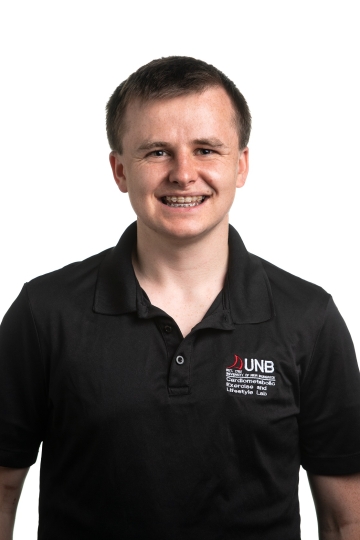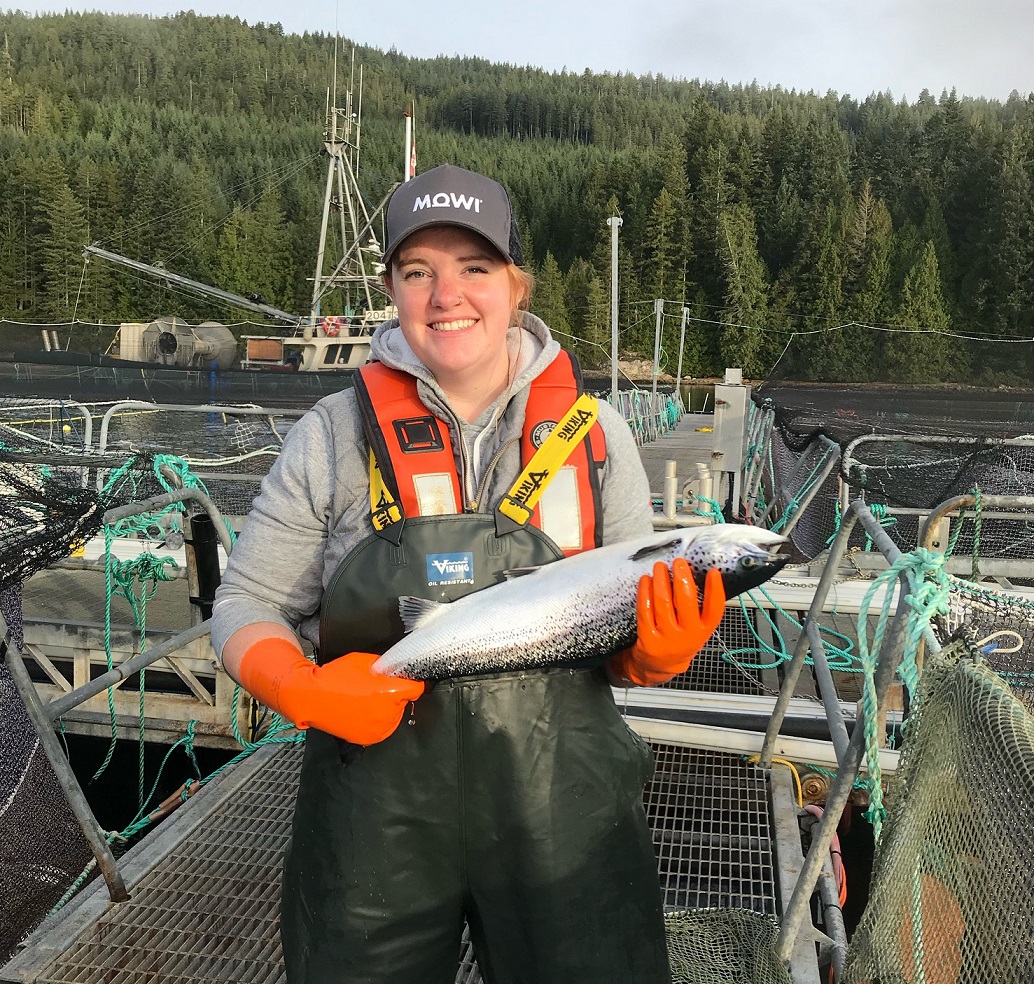
Terra MacDonald at aquaculture site holding farmed salmon.
Terra MacDonald (she/her)
Veterinarian and Fish Health Manager
Mowi Canada West
Learn About My Career
As the veterinarian for Mowi Canada West, I care for the salmon at all life stages, from egg to harvest.
I was born/grew up in: I was born in Nova Scotia, and grew up all around the Maritimes including Nova Scotia, Prince Edward Island, and New Brunswick.
I now live in: I live in Campbell River, British Columbia.
I completed my training/education at: I attended the Nova Scotia Agricultural College where I got my Bachelor of Science, majoring in Animal Science. After that, I attended the Atlantic Veterinary College and got my Doctor of Veterinary Medicine
I do a lot on data analysis and tracking trends. Most of my day-to-day activities and decision making are based on that analysis. I gather data about fish health. This includes such things as fish losses, sea lice levels, feeding rates, growth rates, and environmental issues. Much of this data is reported to our regulator (Department of Fisheries and Oceans – DFO). I spend a lot of time putting together these reports for DFO.
As a veterinarian, I work with every department within Mowi. This includes saltwater production, freshwater production (hatcheries), operations, harvesting, environmental departments, and the production plants. Having a strong understanding of basic fish health, biosecurity (the prevention of the introduction or spread of disease or biological agents), and communication skills are key. I depend a lot on my direct team of fish health biologists. We work out of a lab/office space. A large portion of our time is spent out in the field, travelling to the various sites. The sites are widespread along the coast of Vancouver Island. To get to most sites involves at least 2 hours of driving plus an hour or more on a boat. On the bright side, we get to enjoy some of the most beautiful, remote locations across the province. There’s rarely a bad day when you’re out on the water!
When out on site we are usually examining fish. We do this with either necropsies (examining fish that have died) or live fish. When we study live fish, they are sedated for a short period so we can check their gills and skin. Samples may be taken for disease detection and screening (PCR, histology, bacteriology).
I’ve wanted to be a veterinarian since I was very young. My studies throughout high school and into my undergraduate degree were geared towards that goal. When I was in my first year of university, I got a job helping out with some nutrition trials with Atlantic salmon, rainbow trout, and arctic char. This was my first introduction to aquaculture. I grew up in an agriculture background, with dairy farms on both sides of my family. As a result, I saw immense potential in aquaculture. I saw it as a way to achieve sustainable and healthy food production without increasing pressure on wild fisheries.
I continued to work with fish throughout my undergraduate degree. By the time I went to vet school, I knew I wanted to be a fish veterinarian. I took summer jobs that gave me exposure in research, regulatory affairs, and field roles. I shadowed veterinarians from Norway and British Columbia to get an idea of what medicine looked like in this area.
When I graduated, there were no fish jobs immediately available. I took a position with a small animal general practice (cats and dogs) in Edmonton, Alberta. I did this for a couple years until an aquatic veterinarian position became available in British Columbia. I really enjoyed the general practice. To this day, I still do some “relief” services where I fill in at small animal clinics on weekends and holidays. I really enjoy the variety of work I can do as a veterinarian. I love working in aquaculture, and really enjoy fish medicine. However, getting to spend some time in a clinic is great as well.
I enjoy that I am part of food production in a meaningful way. I feel that food production needs to move in a new direction. I believe that aquaculture can be a big part of that. I am passionate about public health, environmental health, and fish medicine in general. This role allows me to be part of all those things. I find fish, especially salmon, fascinating. I find that I’m constantly learning new things. I love that every day is different. It’s impossible to become bored in such a fast-paced environment. I also love the ocean. I feel very, very lucky to be able to work in the field I do!
I believe that my position makes a difference by providing sustainable, healthy food to a growing population. The advances made in salmon aquaculture help to move towards more “blue” food production. This is in line with several of the United Nations Sustainable Development goals. This includes such big topics like Life Below Water, Zero Hunger, and Climate Action. As a veterinarian, I always take into consideration the health of the animals. I also consider the health of the environment and the health of people. It’s important to realize that these conditions interact and depend on each other.
I love being on the ocean in my personal time as well. I love to kayak, paddle-board, and beach comb whenever I can. I’ve been recently introduced to sailing and have been enjoying another way to be out on the water. As I mentioned before I also do some relief work at clinics on weekends/holidays. I find this is a refreshing change of pace. I also do at-home euthanasia services for dogs and cats. This is a really profound and rewarding position, and I feel very privileged to be part of those hard moments for families. I enjoy weight lifting and CrossFit as well. I have a really great gym community that keeps me sane and in good shape for my job, which can be very physical! Being able to lift big fish is a must!
I would say reach out to people who are in the position you want to be in. Shadow them, if possible, and ask lots of questions. Mentorship is so important. Getting advice from someone who is in a similar position as the one you are thinking about is a great place to start. It also allows you some insight into whether it would actually be something you’d like to do. Also – don’t feel pressured to jump right into post-secondary education right out of high school. There is a lot of benefit to taking time to figure out what you really want to do before making a big time (and financial!) commitment.
What I do at work
I do a lot on data analysis and tracking trends. Most of my day-to-day activities and decision making are based on that analysis. I gather data about fish health. This includes such things as fish losses, sea lice levels, feeding rates, growth rates, and environmental issues. Much of this data is reported to our regulator (Department of Fisheries and Oceans – DFO). I spend a lot of time putting together these reports for DFO.
As a veterinarian, I work with every department within Mowi. This includes saltwater production, freshwater production (hatcheries), operations, harvesting, environmental departments, and the production plants. Having a strong understanding of basic fish health, biosecurity (the prevention of the introduction or spread of disease or biological agents), and communication skills are key. I depend a lot on my direct team of fish health biologists. We work out of a lab/office space. A large portion of our time is spent out in the field, travelling to the various sites. The sites are widespread along the coast of Vancouver Island. To get to most sites involves at least 2 hours of driving plus an hour or more on a boat. On the bright side, we get to enjoy some of the most beautiful, remote locations across the province. There’s rarely a bad day when you’re out on the water!
When out on site we are usually examining fish. We do this with either necropsies (examining fish that have died) or live fish. When we study live fish, they are sedated for a short period so we can check their gills and skin. Samples may be taken for disease detection and screening (PCR, histology, bacteriology).
My career path is
I’ve wanted to be a veterinarian since I was very young. My studies throughout high school and into my undergraduate degree were geared towards that goal. When I was in my first year of university, I got a job helping out with some nutrition trials with Atlantic salmon, rainbow trout, and arctic char. This was my first introduction to aquaculture. I grew up in an agriculture background, with dairy farms on both sides of my family. As a result, I saw immense potential in aquaculture. I saw it as a way to achieve sustainable and healthy food production without increasing pressure on wild fisheries.
I continued to work with fish throughout my undergraduate degree. By the time I went to vet school, I knew I wanted to be a fish veterinarian. I took summer jobs that gave me exposure in research, regulatory affairs, and field roles. I shadowed veterinarians from Norway and British Columbia to get an idea of what medicine looked like in this area.
When I graduated, there were no fish jobs immediately available. I took a position with a small animal general practice (cats and dogs) in Edmonton, Alberta. I did this for a couple years until an aquatic veterinarian position became available in British Columbia. I really enjoyed the general practice. To this day, I still do some “relief” services where I fill in at small animal clinics on weekends and holidays. I really enjoy the variety of work I can do as a veterinarian. I love working in aquaculture, and really enjoy fish medicine. However, getting to spend some time in a clinic is great as well.
I am motivated by
I enjoy that I am part of food production in a meaningful way. I feel that food production needs to move in a new direction. I believe that aquaculture can be a big part of that. I am passionate about public health, environmental health, and fish medicine in general. This role allows me to be part of all those things. I find fish, especially salmon, fascinating. I find that I’m constantly learning new things. I love that every day is different. It’s impossible to become bored in such a fast-paced environment. I also love the ocean. I feel very, very lucky to be able to work in the field I do!
How I affect peoples’ lives
I believe that my position makes a difference by providing sustainable, healthy food to a growing population. The advances made in salmon aquaculture help to move towards more “blue” food production. This is in line with several of the United Nations Sustainable Development goals. This includes such big topics like Life Below Water, Zero Hunger, and Climate Action. As a veterinarian, I always take into consideration the health of the animals. I also consider the health of the environment and the health of people. It’s important to realize that these conditions interact and depend on each other.
Outside of work I
I love being on the ocean in my personal time as well. I love to kayak, paddle-board, and beach comb whenever I can. I’ve been recently introduced to sailing and have been enjoying another way to be out on the water. As I mentioned before I also do some relief work at clinics on weekends/holidays. I find this is a refreshing change of pace. I also do at-home euthanasia services for dogs and cats. This is a really profound and rewarding position, and I feel very privileged to be part of those hard moments for families. I enjoy weight lifting and CrossFit as well. I have a really great gym community that keeps me sane and in good shape for my job, which can be very physical! Being able to lift big fish is a must!
My advice to others
I would say reach out to people who are in the position you want to be in. Shadow them, if possible, and ask lots of questions. Mentorship is so important. Getting advice from someone who is in a similar position as the one you are thinking about is a great place to start. It also allows you some insight into whether it would actually be something you’d like to do. Also – don’t feel pressured to jump right into post-secondary education right out of high school. There is a lot of benefit to taking time to figure out what you really want to do before making a big time (and financial!) commitment.
When I was a student I enjoyed:
- Art
- Science
- Math
When I was a student, I would describe myself as someone who:
- Enjoyed doing things on my own
- Liked helping people
- Was motivated by success
- Liked reading
- Engaged in volunteer activities
- Felt at home in the outside, natural environment
- Learned best “by doing"
- Always knew exactly what I wanted to do
- Played clarinet and saxophone.
- Had part time jobs including Tim Hortons and A&W
Partners
Canadian Aquaculture Industry Alliance (CAIA)
Let's Talk Science would like to thank the Canadian Aquaculture Industry Alliance (CAIA) for connecting us with the individual profiled above.
The Canadian Aquaculture Industry Alliance (CAIA) is the national association that speaks for Canada’s seafood farmers, representing their interests in Ottawa to regulators, policy makers and political leaders. Check their website to learn about the Aquaculture Industry in Canada, how this industry contributes to the production of a sustainable food supply, and the benefits of a seafood diet.

Related Topics
Explore More Career Profiles
-
Brianna Lummerding
Career Profiles
Agronomic Innovation Manager
I look after all things related to soil management for a group of retailers. -
Li Tan (he/him)
Career Profiles
Molecular Lead
I coordinate the day-to-day operations in the DNA Extraction Lab. -
Tyler Morhart (video)
Career Profiles
Scientist, Beamline Responsible - SyLMAND
I am responsible for the SyLMAND beamline at the Canadian Light Source synchrotron facility. -
Li Tan (Video)
Career Profiles
Molecular Lead
I coordinate the day-to-day operations in the DNA Extraction Lab. -
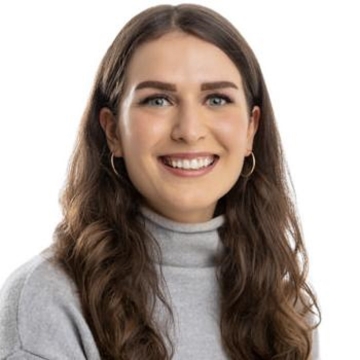
Rashell Featherstone (she/her)
Career Profiles
Senior Program Associate
I coordinate projects for the development of new products at STEMCELL. -
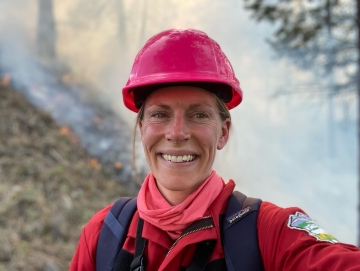
Kira Hoffman (she/her)
Career Profiles
Postdoctoral Researcher/Fire Ecologist
I am a researcher at both a university and a not-for profit organization where I am gaining experience to become a senior researcher. -
Zoë Ehlert (Video)
Career Profiles
Manager, Marker Assisted Breeding
I lead a team that develops canola crops by breeding plants with traits we are looking for. -
Zoë Ehlert
Career Profiles
Manager, Marker Assisted Breeding
I lead a team that develops canola crops by breeding plants with traits we are looking for. -
Jennifer Baltzer (she/her)
Career Profiles
Professor and Canada Research Chair in Forests and Global Change
I work at a university, teaching students and conducting research on the impact of climate change on forests in Canada and around the world. -
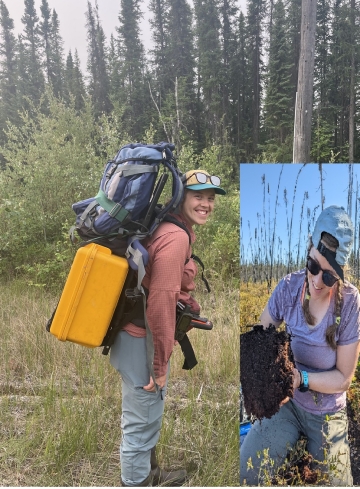
Caitlyn Lyons (she/her)
Career Profiles
Ph.D. Candidate
I am working towards my PhD and studying the forests in the Northwest Territories. -
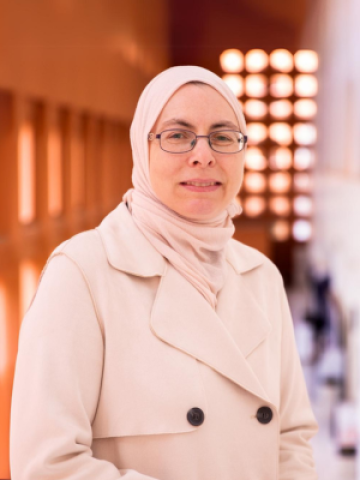
Joann Whalen
Career Profiles
Professor at the Faculty of Agricultural and Environmental Sciences,
I teach advanced courses on how to manage soils to produce healthy, nutritious food and maintain healthy ecosystem functions.
